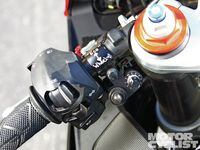Wrist: Ari Henning
MSRP (2010): $15,999
Miles: 1920
MPG: 25
Mods: Aprilia forged-aluminum wheels, Drive Systems sprockets, DID chain, Bazzaz Z-Fi TC, Woodcraft rearsets
My long-term Aprilia is losing flab faster than a Lap-Band patient! In my last update the RSV4 was just 1 lb. shy of the 459-lb. RSV4 Factory, and now it’s a full 9 lbs. lighter than the upscale model. The majority of that weight reduction was achieved by swapping the R’s cast-aluminum hoops for the Factory’s forged ones. The $2400 price tag is substantial, but so was the weight savings: 11.4 lbs. in total. That’s a big deal any way you slice it, but the fact that this is unsprung, rotating mass means it has a _huge _effect on handling. As an additional benefit, I can keep the original-equipment Metzelers on the cast wheels and swap the entire assemblies instead of changing tires. The brake discs need to be transferred, but that’s still quicker and easier than mounting and balancing buns. A second set of rotors for the track would make things even easier.
I cut an additional 1.4 lbs. by changing out the stock #525 chain and sprockets for narrower and lighter #520 components from Drive Systems ($251.95; www.drivesystemsusa.com). The kit includes the company's Superlight steel sprockets and a DID ERV3 X-ring chain cut to length. I selected a one-tooth-smaller countershaft sprocket to gear the bike down for better acceleration and to help keep the big V4 from lugging at low speeds in first gear as it did with the tall stock gearing. I was concerned that the Aprilia would put too much strain on the slimmer chain, but after a day at the track it hadn't stretched a bit.
The RSV4's abysmal fuel mileage has been weighing on me heavily. I'm pleased to see that the 2011 RSV4s aren't as thirsty, but the fuel and exhaust flapper valve updates that help them run more efficiently are at odds with my desire for more horsepower. Using some clever electronics from Bazzaz (www.bazzaz.net), I'm hoping to have my cake and eat it, too. The company's Z-Fi TC module ($949.95) is tunable via a laptop and can store two fuel maps, so I can have a full-power map for the track and a leaner "economy" map for road use, selectable via the accessory switch cluster ($129.95). I've created a more efficient map using Bazzaz's AFM module ($299.95), but haven't yet logged enough miles to note how much mileage has improved. If the RSV4's onboard computer is any indication, I'm up a few mpg.
Installing the Bazzaz electronics was an adventure. The box contains a tangle of wires and connectors that must be routed throughout the bike, which requires the removal of the bodywork, gas tank and airbox. When I pulled the lid off the airbox, I made a disturbing discovery: While the RSV4 uses a quality K&N-style cotton-gauze air filter, Aprilia leaves it dry to improve airflow. That's fine on a racebike that will have its engine rebuilt every season, but insufficient protection for a bike expected to last tens of thousands of miles. With no oil on the gauze to capture dust, the inside of the airbox was coated in a thick layer of grime that extended down into the velocity stacks. Yikes! After washing the airbox and cleaning and oiling the filter with K&N filter oil ($8.18; www.knfilters.com) I drained the contaminated engine oil and changed the oil filter. If you own an RSV4, oil your air filter ASAP!
The Bazzaz Z-Fi TC package includes traction-control software and a quick-shifter, but installing the quick-shifter switch requires aftermarket rearsets since the stock shifter doesn't use a linkage shaft. I ordered a set of Woodcraft rearsets ($399.99; www.woodcraft-cfm.com) since they were the most affordable option on the market. The quick-shifter works flawlessly and is addicting to use, but so far the traction control doesn't seem to work as well as it could. Thankfully the system is fully adjustable, so I'll be working on dialing-in the sensitivity and intervention level the next time I head to the track.















/cloudfront-us-east-1.images.arcpublishing.com/octane/HXOUJXQWA5HBHGRO3EMJIGFMVI.jpg)

/cloudfront-us-east-1.images.arcpublishing.com/octane/3TIWWRV4JBBOLDVGRYECVVTA7Y.jpg)
/cloudfront-us-east-1.images.arcpublishing.com/octane/KIX5O23D5NAIBGFXBN3327DKZU.jpg)
/cloudfront-us-east-1.images.arcpublishing.com/octane/7GJYDUIPXRGMTMQKN6ONYOLBOU.jpg)
/cloudfront-us-east-1.images.arcpublishing.com/octane/MUQLOVLL2ZDGFH25ILABNBXKTI.jpg)
/cloudfront-us-east-1.images.arcpublishing.com/octane/TNOU5DNE2BC57MFPMGN2EIDXAM.jpg)
/cloudfront-us-east-1.images.arcpublishing.com/octane/GTCXACQGJ5HAPDTGWUQKDEH44E.jpg)
/cloudfront-us-east-1.images.arcpublishing.com/octane/S35YGSEMEZB4BLTDJTSZPF4GLA.jpg)
/cloudfront-us-east-1.images.arcpublishing.com/octane/5UOT6HPX2JFMRJAX6EH45AR4MQ.jpg)
/cloudfront-us-east-1.images.arcpublishing.com/octane/OKWOJWAKP5EP3OACCRRWPCIX2Q.jpg)
/cloudfront-us-east-1.images.arcpublishing.com/octane/2WF3SCE3NFBQXLDNJM7KMXA45E.jpg)
/cloudfront-us-east-1.images.arcpublishing.com/octane/G4MG6OUCJNBSHIS2MVVOTPX65E.jpg)
/cloudfront-us-east-1.images.arcpublishing.com/octane/IIGGWFOTOJGB7DB6DGBXCCMTDY.jpg)
/cloudfront-us-east-1.images.arcpublishing.com/octane/QSTCM6AVEZA5JJBUXNIQ3DSOF4.jpg)
/cloudfront-us-east-1.images.arcpublishing.com/octane/U4I7G625B5DMLF2DVIJDFZVV6M.jpg)
/cloudfront-us-east-1.images.arcpublishing.com/octane/B6XD6LS6IVCQPIU6HXDJSM3FHY.jpg)
/cloudfront-us-east-1.images.arcpublishing.com/octane/ICL63FEDDRDTTMINYICCEYGMDA.jpg)
/cloudfront-us-east-1.images.arcpublishing.com/octane/FCGZHQXRBZFLBAPC5SDIQLVF4I.jpg)
/cloudfront-us-east-1.images.arcpublishing.com/octane/WNOB6LDOIFFHJKPSVIWDYUGOPM.jpg)

/cloudfront-us-east-1.images.arcpublishing.com/octane/X33NU3E525ECRHXLNUJN2FTRKI.jpg)
/cloudfront-us-east-1.images.arcpublishing.com/octane/6KKT5NNL2JAVBOXMZYS5ZO76YA.jpg)
/cloudfront-us-east-1.images.arcpublishing.com/octane/J5RKG5O455GMPGQRF2OG6LRT7A.jpg)